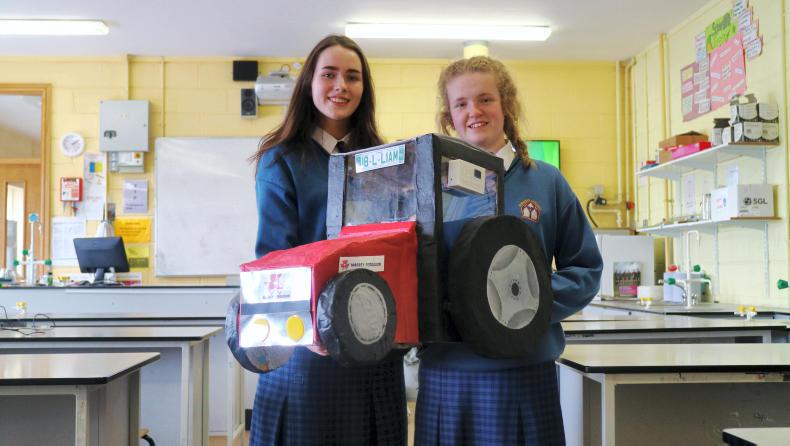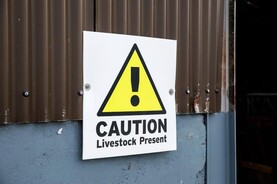School 3: Coláiste Chraobh Abhann
Students: Alex Brady and Jack Brady.
Year: Transition year.
Teacher: Aoife Kehoe.
Idea: Loading Livestock Aid.
Alex and Jack Brady are TY students in Coláiste Chraobh Abhann, Kilcoole, Co Wicklow. The Loading Livestock Aid has the aim to prevent injuries and deaths while farmers load their livestock.
Both men explained to the Irish Farmers Journal how the device works: “Loading Livestock Aid has the aim to prevent injuries and deaths while farmers load their livestock. Once our device is engaged, it will only allow the gate to move in one direction. If the livestock kick the gate or apply pressure, our device will lock. This will result in our device taking the brutal force of the impact, allowing the farmer to remove themselves from the potential dangers.”
The device consists of a spring-loaded bar fitted to the gate post which they say can be activated by a lever on the trailer gate. “Once the bar is engaged, it moves through a set of ratchet teeth. If the livestock were to apply force, the bar will be locked in between these teeth, preventing the gate from swinging freely. The aim of our product is to stop the gate from flying back and possibly injuring the body of the farmer,” both students explained.
“From conducting research and surveys, we believe that our product is original and there isn’t anything on the market that can be purchased and fitted to livestock trailers with the same aim as our device,” Jack and Alex said.
Both students explained where the idea originated from and feel it could offer real benefits to farmers. “According to the Health and Safety Authority, 16% of deaths on our Irish farms were due to livestock-related accidents since 2009. We are young agricultural enthusiasts who feel that it is our duty to make sure farmers feel less vulnerable. We also believe that we are in a position to be able to reduce fatalities and injuries while farmers load their livestock. We must remember that not all injuries are recorded. Therefore, loading livestock could actually be more of a danger and pressing issue to farmers than we previously believed. Now, we are focusing on turning our device into a product and getting it out to market as soon as we can,” they stated.
Inspiration
Both Jack and Alex have a passion for farm safety. “We had the desire and ambition to centre our project on the whole theme of loading livestock. We constantly felt anxious due to the hidden dangers that our parents face daily.
“One of the main reasons that we began this journey was because a family friend was seriously injured when he was loading his livestock. Shock and a sense of panic hit us both as we couldn’t imagine an accident occurring to one of our parents. We have realised that cattle can become excited and, to a certain extent, quite aggressive while they are being transported,” they said.
“In the small space in which loading livestock occurs, it is evident that the farmer wouldn’t be protected if a cow were to kick or push against the trailer gate during this procedure. Fortunately, nothing has happened to our parents, but you can understand how accidents may occur,” they added.
What it would mean to win
“Winning the ESB Networks National Safety Challenge would mean everything to us. Not only would it make us feel like our time was well spent but the thought of potentially saving someone’s life is so rewarding. We have worked tremendously hard over the past year and we are not finished our farm safety journey yet. This competition will allow us to continue developing our device and start fitting it to livestock trailers nationwide. In return, we hope this will reduce the numbers of injuries and deaths on our Irish farms.”

Kayla McMahon and Fiona Kelly from Desmond College.
School 4: Desmond College
Students: Kayla McMahon and Fiona Kelly.
Year: Transition year.
Teacher: Donal Enright.
Idea: Eye in the Cab.
Kayla McMahon and Fiona Kelly from Desmond College, Newcastle West, Co Limerick, have developed Eye in the Cab, a device that you attach in the cab of a tractor.
It detects the angle that the tractor is at and alerts the farmer if they are operating at a dangerous angle.
The students explained to the Irish Farmers Journal how their device would work: “It detects what angle the tractor is at constantly. This device is linked to a GPS device which monitors the tractor’s location at any given time. If the tractor’s angle reaches a certain point (likely turning over), it will send a text message to the In Case of Emergency (ICE) contact of the person in the tractor and also send the tractor’s location.”
The students made use of some sophisticated technology to put the plan together: “Using a gyro sensor, GPS modules and an auto dialler, we built a device that recognises the angle of the tractor. Gyro sensors, also known as angular rate sensors, are devices that sense angular velocity.
“With the aid of an internal siren, it can alert the driver once a tractor has reached a 35° tilt and can alter the driver’s ICE contact via a STMicroelectronics SPBTLE-RF Bluetooth Chip 4.1 auto-dialler, once the vehicle has reached or exceeded 45° angle. The Eye in the Cab device can be fixed to the inside of the cab via magnets. It is also equipped with an emergency button on the front panel that the driver can press in an emergency.
“Because it is portable, the driver can take the unit with them and attach it to their belt in case they are involved in an accident involving animals, machinery or overcome by slurry fumes.”
Inspiration
The two students said the main inspiration for the idea came from the fatality rates in agriculture.
“Agriculture is a huge part of the lives of the people in Ireland. The fatality rate from workplace accidents in agriculture is far higher than any other economic sector. According to research carried out by the Health & Safety Authority (HSA), machinery-related accidents make up for 50% of farm fatalities,” Kayla and Fiona explained.
“Factors that influence the probability of vehicles tipping over are the size, weight, angle of incline, terrain, front and back loaders as well as tyre size and pressure. The multiplicity of factors make it difficult for the driver to be completely safe. Our device will serve as an early mechanism and help reduce accidents. However, research informs us that when a tractor reaches an angle of 36.78°, it has a 75% chance of rolling over and at 45°, it has a 100% chance,” they outlined.
What it would mean to win
“It would mean a lot to us to win the ESB Networks National Safety Challenge and especially to know that even at our young age we could potentially save lives with an idea and project that we came up with ourselves. It would be a massive achievement for us and our school,” Kayla and Fiona concluded.
DISCLAIMER: The products and designs listed were judged and awarded prizes for the purpose of the ESB Networks National Safety Challenge only. ESB Networks does not own or endorse these products or designs.





SHARING OPTIONS: